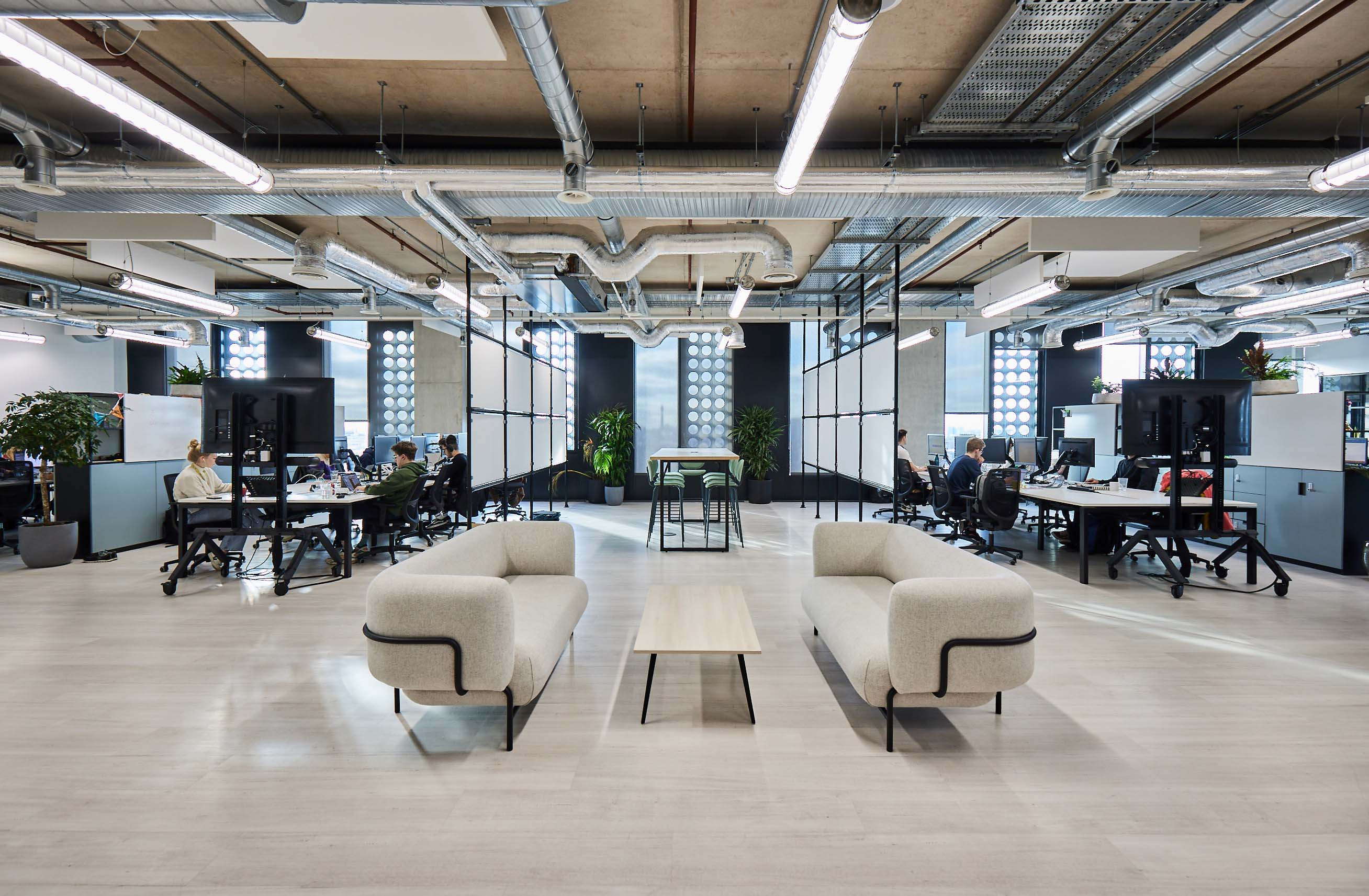What can learning environments teach the working world?
Looking to attract and retain the next generation of talent? You may want to take inspiration from...
Here's how a learning culture in the workplace can enhance overall performance and wellbeing.

In today's rapidly evolving business landscape, organisations must continuously adapt and innovate to stay ahead. One key factor that drives success in the workplace is the cultivation of a learning culture. This mindset encourages innovation, knowledge sharing, upskilling, and employee engagement, leading to increased productivity and stronger teams. But how do you give learning a more central role at work? Harness the power of office interior design.
The benefits of a learning culture go beyond just providing training opportunities; it creates an environment that promotes continuous learning, growth, and development. By fostering a learning culture, you can empower your employees, help them to feel valued and committed to the business, enhance overall performance and gain a competitive edge in the market. Here are some key benefits to consider:
New generations entering the workforce, influenced by their educational experiences, value and recognise learning and upskilling as essential components of their career development. Creating a learning culture also helps to bridge generational differences within the workforce, ensuring everyone feels valued and engaged. This, in turn, leads to higher job satisfaction, increased morale, and improved overall wellbeing. Employees who feel supported in their professional development are more likely to be loyal to the organisation and have a healthy work-life balance.
Recent years have proven that adaptability is a crucial skill that helps businesses stay ahead of the curve, and it’s more important than ever to nurture an agile workforce that can respond proactively to adversity. Employees who embrace a learning culture are more open to new ideas, technologies, and ways of working, enabling the organisation to quickly adapt to market trends and seize opportunities. This skill can also help businesses that are going through a period of high growth, restructure or innovation.
When employees are encouraged to share knowledge and collaborate, it creates a positive and supportive work environment. A learning culture promotes teamwork, boosts creativity, and enhances problem-solving capabilities. When employees are encouraged to learn and explore new ideas, they are more likely to think outside the box and come up with innovative solutions unlocking the full creative potential of the team, leading to breakthrough ideas and improved processes.


Now that we know how upskilling and investing in the skillset of your teams can help your business and its people to grow and flourish, we can explore how be to implement this through office space planning, office interior design and technology adoption. Here are some steps you can take to achieve this:
A recent article from Steelcase highlighted employee mindset as an important stepping stone to bringing about growth and innovation within a business. It said that ‘bringing teams together in collaborative and creative ways shifts the collective mindset’ to a state of ‘always-on’ learning, building strong networks.
Encourage your employees to embrace experimentation and innovation. Celebrate mistakes as learning opportunities and promote a supportive environment where individuals feel comfortable taking risks and trying new approaches. Recognise and reward creativity, curiosity, and the pursuit of learning to foster a culture that encourages growth, inspires innovation, and drives positive change within your organisation.
Technology plays a vital role in enabling a learning culture. Embrace digital tools, learning management systems (LMS), and online platforms that provide easy access to resources, webinars, and training modules. Invest in office interior design that seamlessly integrates technology into the daily experience, such as flexible workstations and collaborative spaces equipped with state-of-the-art communication tools. Embracing technology in your learning initiatives will make it more accessible, flexible, and engaging for your employees.
Collaboration is a cornerstone of a successful learning culture. Designate areas within your office where employees can come together to share ideas, brainstorm, and collaborate. These collaborative spaces can include communal workspaces, breakout rooms, and open areas for impromptu meetings and knowledge-sharing sessions.
By providing these dedicated spaces, you encourage cross-departmental collaboration, foster a sense of teamwork, and facilitate the exchange of innovative ideas. Your office interior design and layout should support collaborative work modes, creating an environment that promotes interaction and engagement.
Brainlabs approached Peldon Rose with collaboration at the top of the agenda for its new destination workplace. With a desire to experiment and push the boundaries in the marketing arena, the business needed a space that allowed them to come together, test, learn, adapt and innovate in a fluid and always-moving environment. We created a pioneering space for Brainlabs that gave its team the power to learn and grown, be bold and ambitious.


Provide a range of learning opportunities tailored to different learning styles and preferences. This can include workshops, seminars, webinars, mentorship programs, and online courses. Collaborate with industry experts and encourage employees to attend conferences and external training programs, boosting their professional development and broadening their knowledge.
By endorsing these opportunities, you empower your employees to enhance their skills, stay updated with industry trends, and grow both personally and professionally. This investment in their development demonstrates your commitment to their success and cultivates a culture of continuous learning as well as strengthening retention and connection. Learning opportunities are high on employees’ priorities at work, and with 79% of the global workforce claiming to be unengaged and demotivated at work, offering ways to reconnect your people with the work and their purpose through learning will reinforce their passion and loyalty.
Facilitating learning and training was central to Preqin’s brief when they employed Peldon Rose to create its new home in Victoria, London. With area such as bleachers, semi-private huddle spaces and private rooms equipped for interactive learning and seminars, Preqin have everything they need to train the best industry talent.


Make learning a shared value across all levels of the organisation. Encourage managers and leaders to lead by example, demonstrating their commitment to continuous learning. Recognise and reward employees who actively engage in learning activities, fostering a culture where knowledge acquisition is celebrated.
Learning is ongoing; learning doesn’t stop after a training session or seminar, and is for the everyday, not just for preparing to step into a higher role. Companies that operate continuous learning initiatives are 46% more likely to be first to market. Connecting employees’ personal goals with business goals creates better employee engagement and a shared value in the pursuit of continuous, consistent learning.
Regularly assess the impact of your learning initiatives. Use data analytics and feedback mechanisms to gauge employee satisfaction, knowledge growth, and the effectiveness of different learning programmes. Evaluation will help you tailor learning opportunities to meet the specific needs of your workforce, and undergoing an office relocation or refurbishment is a great time to evaluate and modify your plans.
To ensure your methods are effective, key metrics you can measure are employee engagement, satisfaction, productivity, and retention rates. Conduct pulse surveys to identify areas for improvement and refine your approach. By tracking these metrics, you can make data-driven decisions, demonstrate the value of your learning culture initiatives, and continuously enhance your programmes to meet the evolving needs of your workforce.
Building a learning culture requires a holistic approach that encompasses office interior design, space planning, and change management to foster collaboration and growth. At Peldon Rose, we understand the vital role your office plays in facilitating growth.
Whether you're looking to create collaborative spaces, incorporate technology, or revitalize your office environment, we can help. Our dedicated team will work with you to transform your workspace into a hub of creativity, innovation, and learning.
Get in touch today and let us support you on your journey to creating a dynamic learning culture within your workplace. Together, we can achieve exceptional results for your business and its people.

Looking to attract and retain the next generation of talent? You may want to take inspiration from...

At Peldon Rose, investing in the future of the design and build industry is important to us, and we’re...

We're still celebrating our win at the Business Culture Awards last month. We'd like to talk about why we...

We caught up with our 2022/23 cohort of design interns about working at Peldon Rose.

Your workplace holds enormous potential to improve your business performance. Get in touch today, and we will unlock that potential together.